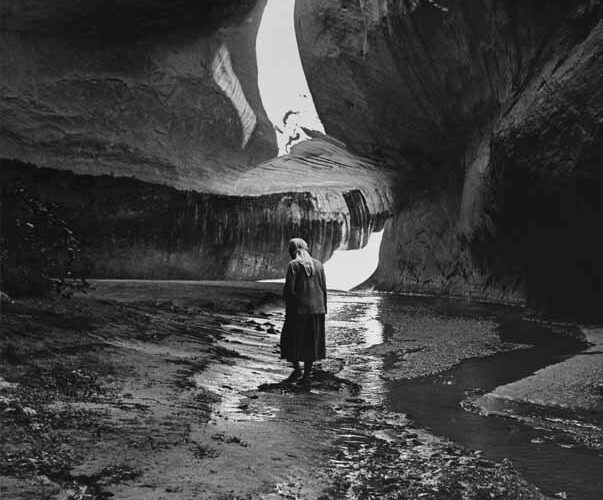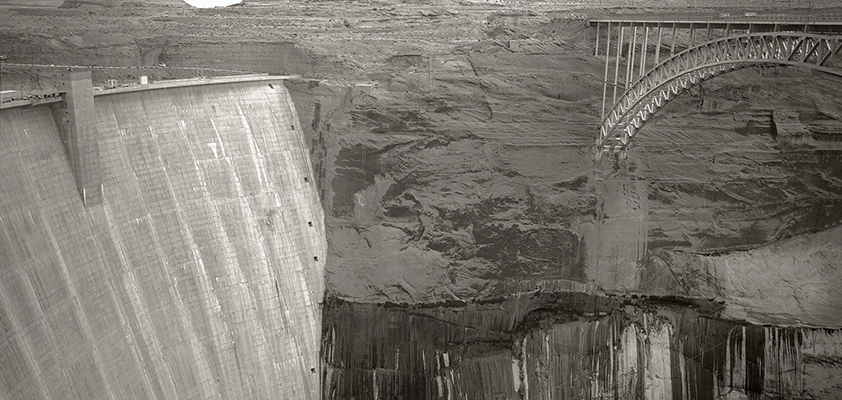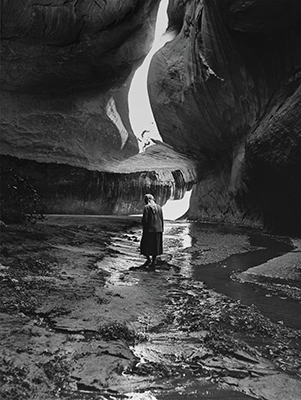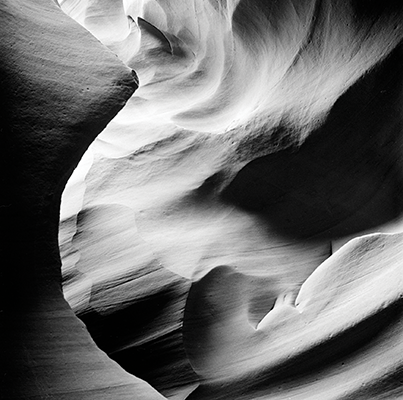The Canyon Under the Lake
A new exhibition reckons with Glen Canyon’s past and Lake Powell’s future
 Todd Webb, Georgia O’Keeffe at Glen Canyon, 1961. Gelatin silver print. Gift of the Georgia O’Keeffe Foundation. Courtesy of the Georgia O’Keeffe Museum, 2006.6.998. Todd Webb Archive, Portland, Maine, U.S.A.
Todd Webb, Georgia O’Keeffe at Glen Canyon, 1961. Gelatin silver print. Gift of the Georgia O’Keeffe Foundation. Courtesy of the Georgia O’Keeffe Museum, 2006.6.998. Todd Webb Archive, Portland, Maine, U.S.A.
BY KATHERINE WARE
Some places are so special that we can’t wait to visit them again and again. For many artists, the area known as Glen Canyon on the Colorado River was one such exceptional place. Photographer Eliot Porter first visited in 1960 and immediately made plans to return. Georgia O’Keeffe joined him on several trips down the Colorado, twice at age seventy-four and again a few years later. Cinematographer and photographer Tad Nichols was a regular fixture at Glen Canyon, shooting commercial footage and thousands of negatives there. He was often joined by Katie Lee, a vivacious folk singer and actress who considered Glen Canyon the love of her life. Scout troops ran the river. Theodore Roosevelt, Barry Goldwater, and Stewart Udall each floated down the Colorado, though not on the same trip. And some of the foremost writers of the mid-twentieth century took Glen Canyon as their subject, prominent among them Edward Abbey, John McPhee, and Wallace Stegner.
This widespread reverence continued until 1963, when the construction of the Glen Canyon Dam was completed, submerging much of the canyon underwater.
When the Sierra Club published the second volume in its popular Exhibit Format series in 1963, The Place No One Knew: Glen Canyon on the Colorado, they were taking artistic liberties with the title. Plenty of people knew about and cherished this ancient river canyon stretching from southern Utah to northern Arizona. But when the U.S. Department of Reclamation established this beautiful stretch of landscape as the site of a new dam and reservoir, awareness dramatically rose.
Long after the dam was built and Lake Powell was named for Captain John Wesley Powell, who first explored the canyon in 1869 and advocated for sustainable development of “the arid lands,” it remains a place that stimulates controversy. A new exhibition, The Great Unknown: Artists at Glen Canyon and Lake Powell at the New Mexico Museum of Art (March 30 through September 15, 2019), tells the story of this transformation through the eyes of some of the artists who were inspired by the place, both before and after the dam was built, and are considering its future. It offers a visual journey guided by these many voices and lenses, reflecting experiences of adventure, friendship, artistic development, and environmental concern.
Carved into an ancient plateau more than a million years ago by what we now call the Colorado River, Glen Canyon is known, like the more famous Grand Canyon, for its vertiginously steep bedrock walls that display about 300 million years of the earth’s geologic development. Red sandstone is a prominent feature of the canyon, which prompted Spanish explorers to refer to the area as colorado (colored red). As a natural source of water and shelter, the canyon has long attracted plants, animals, and people. Ancestral Puebloans began to frequent the canyon as seasonal residents and grew crops along the river starting around the twelfth century BC. They left behind cliff dwellings, numerous petroglyphs, and household goods, a few of which will be on view in the exhibition.
The Colorado Plateau continued to be home to many Indigenous groups, as it is today. European explorers probably first moved through Glen Canyon in the mid-1770s and were followed by American survey teams sent by the government in 1869 and the early 1870s. Many such travelers memorialized their visits by carving their names into the canyon walls, later to be captured in photographs by Todd Webb and Greg MacGregor. In 1880, a rugged band of Mormon settlers arrived and built a road and a mission. And in 1882, a gold rush brought a surge of itinerant miners to the region. By the 1920s, commercial boating outfits were offering tours down Glen Canyon and to Rainbow Bridge.
To-day the walls grow higher and the canyon much narrower. Monuments are still seen on either side; beautiful glens and alcoves and gorges and side canyons are yet found. After dinner we find the river making a sudden turn to the northwest and the whole character of the canyon changed. The walls are many hundreds of feet higher, and the rocks are chiefly variegated shales of beautiful colors—creamy orange above, then bright vermilion, and below, purple and chocolate beds, with green and yellow sands.
—Capt. John Wesley Powell, August 4, 1869, journal entry
The exhibition also focuses on the mid-twentieth-century artists who felt a strong affinity with Glen Canyon, particularly in the mid-1950s and early 1960s, as the Glen Canyon Dam was being constructed. Tad Nichols got hooked after he was invited to film the excitement of a river trip to advertise the services of a boat company. He returned to capture more footage for Walt Disney Productions and the Sierra Club. He also memorialized the imagination of singer and actress Katie Lee, who secured a spot on a river trip by offering to entertain guests as a campfire singer. Lee was transformed by the experience. She, along with Nichols and boatman Frank Wright, forged an improbable but tight-knit trio of friends they called “We Three.”
On their many trips together, Nichols photographed his friends and their favorite places, a selection of which was later published as Glen Canyon: Images of a Lost World, and Lee wrote songs about the river, and journal entries that provided material for two books. Lee became the group’s bard as well as a dedicated activist, ardently protesting the dam. She felt the Glen Canyon was a sacred place, and took every opportunity to immerse herself in the river, or “dance with the Colorado,” preferably in the nude.
Water flows from travertine springs several miles up canyon, and when the silt-laden Little Colorado River runs dry we get to see the true color from those springs. I push my arm into the soft silt banks and find when I pull it out a rainbow of colors—red, light grey, black, coral, blue, yellow, soft green, and brown from strata high above us and far away. Never will I forget looking in to this living, opaque, turquoise jewel, then swimming in it, and I thank whatever powers let me see it, because I have a feeling I shouldn’t be here at all, that I’m looking on something sacred.
—Katie Lee, June 16, 1953, journal entry
Though Lee was not a fan of Porter’s Glen Canyon photographs, preferring Nichols’ black-and-white views, Porter’s early work with color photography helped to prepare him to capture this quality of the place. Around the same time Lee was discovering Glen Canyon, Taos literary legend Spud Johnson took a trip down the river and eagerly convened a group of friends, including Eliot Porter, for a repeat visit. Johnson published Six Taoseños Who Braved the Colorado River, a book that included his hilariously melodramatic account of a trip that set Porter on a new direction in his work. At the time, the photographer was preparing a group of images to complement selections from naturalist Henry David Thoreau’s 1854 book Walden, or Life in the Woods, to honor the upcoming centenary of his death. Art historian Nancy Newhall recommended the project to David Brower, executive director of the environmental advocacy group the Sierra Club, who was passionate about the power of art photographs to motivate its constituency. At the age of sixty, Porter’s first book was published.
On Brower’s front burner at that time was the United States Bureau of Reclamation’s plans to build a new dam to distribute water allotments among the states that had signed the Colorado River Compact in Santa Fe on November 24, 1922, including Arizona, California, Colorado, Nevada, New Mexico, Utah, and Wyoming.
Original plans to locate it on the Green River at Echo Park in Dinosaur National Monument were successfully blocked in large part due to Brower’s leadership of club efforts and organized protests by other environmentalists. The Bureau found another site, Glen Canyon on the Colorado River, which was not a protected natural landmark.
By the end of the 1950s, land for the town of Page, Arizona, had been secured from the Navajo Nation (traded for a larger piece of land in Utah) to provide housing and facilities for workers and their families, and construction was underway.
It was just a few years later, in 1960, when Porter made his first trip to Glen Canyon with Spud Johnson. Porter vividly recalled that experience in a 1988 Albuquerque Journal interview:
From the very first day, I was overwhelmed by the scenery. . . . The monumental structure of the towering walls in variety and color defied comprehension. So powerful was the impression, I didn’t know where to look, what to focus on; and in my confusion, photographic opportunities slipped by.
He returned twice in 1961, prepared to tackle the visual challenges posed by the canyon. His photographs from that year emphasize the brown and red rock surfaces of the canyon, but by 1962 he was creating more colorful, abstract images, taking advantage of the special light in the canyon on which so many visitors remarked.
Brower, who had been working for many years with renowned photographer Ansel Adams to use fine art images to advocate for preservation causes, responded strongly to Porter’s startlingly colorful, abstract images of the threatened canyon. Having worked the year before on a book with Porter, he seized the opportunity to publish the Glen Canyon images as a plea against the dam, which was essentially completed by the time the book was published. Brower shared Porter’s images with legislators, including President Lyndon B. Johnson and Secretary of the Interior Stewart Udall, in hope of changing their minds. His quest was unsuccessful. Ultimately, he considered the failed campaign against the dam one of the great losses of his career, though it arguably ignited the American mid-century environmental movement.
Porter traveled with many companions on these trips, including Georgia O’Keeffe. A sense of shared adventure and fellowship, along with the astounding locale, were pivotal aspects of the Glen Canyon experience. O’Keeffe, who had been in Asia the previous year and was working on a retrospective exhibition, had traveled previously with Porter before their first trip down the Colorado. After going on a commercial river run, the two gathered a group of simpatico souls for their second trip in 1961.
Porter recalled that O’Keeffe “liked looking up out of slot canyons and caves at ‘holes in the sky.’” During stops along the way, she made numerous loose sketches that capture the intersection of land and sky. Several sketches were later developed into preparatory studies, and she is known to have made at least four paintings based on her visits to canyon country. Her painting On the River presents earthen masses surrounding a dynamic void that could be read as a sky, a pool of water, or simply as an abstract shape. On a scenic postcard of the canyon bearing the words “Bureau of Reclamation’s Glen Canyon Project,” she wrote to her friend Charles Wickham Moore in Paris: “I’ll not be over. I just had a fine trip of some 180 miles by rubber boat down the Colorado River. It was wonderful. 7 days on the river. I think you go to the wrong places.”
O’Keeffe’s river trips are well documented, thanks to her dear friend Todd Webb, who had known her and her husband Alfred Stieglitz in New York. Webb and his wife moved to Santa Fe in 1961 at O’Keeffe’s invitation and stayed a number of years, partly in order to be close to her in Abiquiú. Not much inclined toward landscape photography, while in New Mexico, Webb photographed ghost towns and adopted O’Keeffe herself as one of his primary photographic subjects. He made perhaps a dozen landscape photographs and numerous informal images of two river trips, in 1961 and 1964, primarily documenting of the group’s daily life on the trip.
Webb must have enjoyed the journey to some extent, as he chose to run the river again several years later. But in an August 31 diary entry from the first trip, he wrote:
I was somewhat disappointed in the wilderness aspect of Glen Canyon. In the first place the river was filthy— a thick mud that left you a deep brown after a bath. . . . I just don’t get all the tears being shed over the so-called great loss of Glen Canyon. . . . If the lake works out as expected I should think it would be a much more valuable wilderness area. . . . I look forward to a trip in some future year when I can explore a brand new shoreline far above where we traveled on the river.
However, he did take special care with some of his portraits of O’Keeffe in the dramatic setting of canyon country, presenting her in a solitary and heroic light.
Webb’s take was a contrarian exception to the general sentiment among artists and environmentalists. Many who loved Glen Canyon chose not to return after the completion of the dam and subsequent relocation of its pleasures about 500 feet underwater. The dam and the 700-foot-high bridge next to it both received awards for outstanding engineering achievement. But they were built at the end of a time when such monumental construction projects, initiated as part of the American New Deal economy, were enthusiastically viewed as signs of human ingenuity and progress. One notable example, Hoover Dam, situated on the Colorado River at the Arizona-Nevada border, was constructed during the economically depressed 1930s and was lauded as a treasure of modern engineering. It remains a major sightseeing destination today. The Grand Coulee Dam on the Columbia River in the Pacific Northwest was built just a few years later. The Bonneville Power Administration commissioned folk singer Woody Guthrie to write a group of songs to promote hydroelectric power and celebrate the completion of that structure. His well-known 1941 song “Roll on Columbia” includes the line “Your power is turning our darkness to dawn,” while the lyrics for “Grand Coulee Dam” declare it to be greater than the Seven Wonders of the World. Guthrie’s laudatory anthem represents a very different stance than would be prevalent within just a few decades, and was most certainly at odds with the river songs of Katie Lee. Many mourned the erasure of 170 miles of the Colorado.
The greatest booster for the Glen Canyon Dam was Floyd Dominy, who wielded much power and influence as commissioner of the Bureau of Reclamation (or “Wreck the Nation,” as Katie Lee insisted on calling it) from 1959 to 1969. Dominy was passionate about water reclamation and the Glen Canyon project, promising the resulting lake would be the “Jewel of the Colorado.” In fact, to counter Porter’s Sierra Club book, Dominy published a thirty-page promotional brochure titled “Lake Powell: Jewel of the Colorado,” that included his own tribute to Lake Powell along with poems and photographs. There is no question that Dominy was correct in anticipating the tremendous popularity of Lake Powell, still the second largest reservoir in the Western Hemisphere, which became and remains a popular destination for hiking, boating, and general recreation.
Within a generation—thirty years—I predict the river and canyons will bear a decent resemblance to their former selves. Within the lifetime of our children Glen Canyon and the living river, heart of the canyonlands, will be restored to us. The wilderness will again belong to God, the people, and the wild things that call it home.
—Edward Abbey, address at Earth First! event at Glen Canyon, March 1981
A later assessment of the dam as an artistic subject was made in the early 1990s by photographer Martin Stupich, a member of the Water in the West consortium. A landscape photographer often drawn to monuments of human hubris, Stupich was interested in photographing public works projects to create what he called “postcards to the future.” As part of his series Remnants of the First World, Stupich spent time at Glen Canyon Dam, capturing its muscular appearance with an eye toward its storied past, and its uncertain future. His black-and-white images show the dam both as part of the landscape and as an architectural and engineering feature nearly as impressive as the canyon walls.
Joining the ranks of artistic compatriots visiting Glen Canyon and Lake Powell together are photographers Mark Klett and Byron Wolfe, who spent time on a houseboat with writer and activist Rebecca Solnit between 2012 and 2016. The two photographers and writer set out with Porter’s book The Place No One Knew: Glen Canyon on the Colorado as their guide, attempting to find evidence of the places he photographed in the midst of the lake. Their pictures and text critique the legacy of Glen Canyon Dam over the past five decades and speculate about its future and that of water use in the Western states the dam was created to serve. At Lake Powell, “we were trying to see beneath the surface of the present to find the past,” Solnit writes in their 2018 book Drowned River: The Death and Rebirth of Glen Canyon on the Colorado. Somewhere below the bottom of their boat were the canyons and passages photographed by Porter, now “buried treasure you can only see in photographs.”
Their time spent on the river together provided a creatively charged atmosphere for considering “the madness of the past and the terror of the future,” Solnit says. On an initial trip, the group sought the locations (though far below) of Porter’s photographs and measured the distance from their boat to the bottom. On subsequent trips they abandoned that attempt at connection and worked at deepening their looking, their thinking, even in the midst of vacationing families, party boats, and the extraordinary nature of the place itself. Solnit concludes that “Lake Powell is dying and from its corpse the Colorado River is emerging.”
Also teaming up to examine Glen Canyon and Lake Powell in a time of climate change are photographer Peter Goin and writer Peter Friederici, who traveled separately but join their work in the 2016 book A New Form of Beauty: Glen Canyon Beyond Climate Change. Goin’s images offer indelible evidence of drought as the level of the river sits well below long-established high-water marks and buoys. The striking cliffs of Navajo sandstone are marked with a “bathtub ring” that indicates the former height of water in the lake; invasive plant species are prevalent. In his essay in the book, Friederici proposes that we acknowledge our broken bond with nature, writ large in the decision to build the dam at Glen Canyon, and accept that unmediated use of new technologies can have disastrous and long-lasting effects. “There will not be much easy majesty to our way of seeing,” he writes. “We will have to gain a layered appreciation of complexity and flux. And of our own limitations.”
Katherine Ware is curator of photography at the New Mexico Museum of Art, and recently celebrated her tenth year in that role. Among her exhibitions are Con Cariño: Artists Inspired by Lowriders, Tales from a Dark Room, and Earth Now: American Photographers and the Environment.
The Great Unknown: Artists at Glen Canyon and Lake Powell opens March 30 in the New Mexico Museum of Art’s New Wing galleries.



